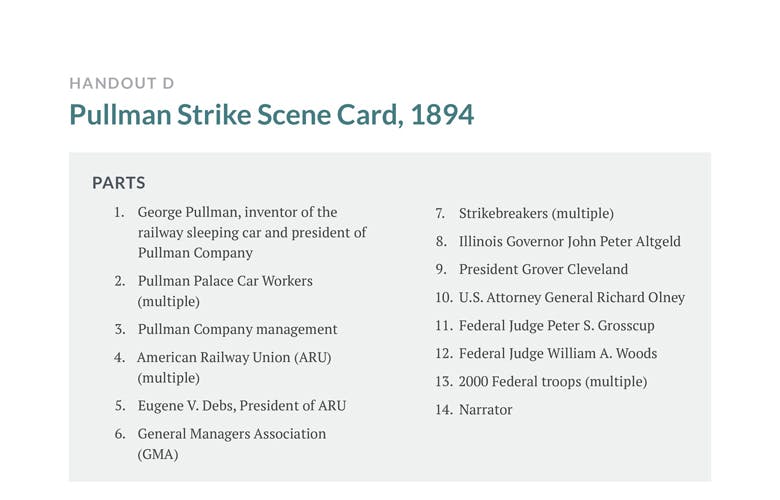Handout D: Pullman Strike Scene Card 1894
Pullman Strike Scene Card, 1894
PARTS
- George Pullman, inventor of the railway sleeping car and president of Pullman Company
- Pullman Palace Car Workers (multiple)
- Pullman Company management
- American Railway Union (ARU) (multiple)
- Eugene V. Debs, President of ARU
- General Managers Association (GMA)
- Strikebreakers (multiple)
- Illinois Governor John Peter Altgeld
- President Grover Cleveland
- U.S. Attorney General Richard Olney
- Federal Judge Peter S. Grosscup
- Federal Judge William A. Woods
- 2000 Federal troops (multiple)
- Narrator
NARRATOR: Scene One: Pullman Company Town near Chicago, Illinois, September 1893 – May 1894
George Pullman announces that, due to the business slowdown during the depression, it is necessary to fire about one-third of the Palace Car Company workers and cut wages by more than 25 percent. At the same time, he refuses to lower rent in the company town, where most Palace Car Company workers are required to live. Workers grumble, but realize that they are fortunate to have jobs and homes at all during a depression, and that they have few options.
NARRATOR: Scene Two: Pullman Company Town near Chicago, Illinois, Spring 1894
Workers at the Pullman factory join the American Railway Union and form a committee to negotiate with Pullman management. Management refuses all of the workers’ demands and fires three members of the workers’ committee. Workers, desperate now because the rent eats up virtually their entire paycheck, decide to go on strike. The next day, George Pullman shuts down the plant. Workers call on Eugene V. Debs and the American Railway Union to support the strike. Pullman management works with 24 railroad companies to form the General Managers Association, in order to develop a nation-wide strategy to defeat the American Railway Union and the strikers. They agree to immediately fire any railroad worker who refuses to move rail cars.
NARRATOR: Scene Three: Railroads in and around Chicago, Illinois, June 1894
Rail traffic near Chicago is paralyzed because ARU members refuse to handle Pullman cars. Union members offer to operate mail trains, but Railroad management officials insist on attaching Pullman cars to mail trains. The strike spreads to railroad workers across the country. Railroad companies fire strikers and hire large numbers of Strikebreakers.
NARRATOR: Scene Four: Washington, D.C. and Springfield, Illinois, June 1894
President Grover Cleveland threatens to become involved; he refers to his responsibility to protect and maintain mail service, as well as prevent disruptions to interstate trade. He says he will send troops if necessary to stop the strike and restore the railroads to normal business. Illinois Governor Altgeld protests, saying the strike is peaceful, the unions have legitimate grievances, and he can prevent disorder by calling on Chicago police and state militia (Remember Gov. Altgeld’s sympathy for the men convicted following the Haymarket Riot; he had pardoned the surviving prisoners in 1892).
NARRATOR: Scene Five: Chicago, Illinois, July 2 – 4, 1894
The General Managers Association works with U.S. Attorney General Richard Olney to secure a federal injunction (court order) against the strikers. Federal judges Peter S. Grosscup and William A. Woods rule that the strike is illegal under the Sherman Anti-Trust Act and order strikers to report to work. When strikers do not return to work the next day, President Cleveland sends more than 2000 Federal troops to crush the strike. The strike prior to this point has been mostly peaceful, but strikers react angrily upon the arrival of troops. They fight against the soldiers, derailing trains, destroying railroad property, and setting widespread fires. In Chicago, at least 13 people are killed and 53 are seriously injured.
NARRATOR: Scene Six: Chicago, Illinois, mid-July, 1894
Debs and several other union leaders refuse the court order and are arrested for interfering with the mail. Debs realizes the strike is doomed, orders the American Federation of Labor to urge affiliate unions to go back to work, and many railroad workers resume their old jobs at the previous pay. However, workers who participated in leadership positions in their local unions are blacklisted, meaning no railroad company in the country will hire them. The strike in Chicago and in other major railroad centers around the country collapses by early August.
NARRATOR: Scene Eight: historical significance
The Pullman Strike was the first labor uprising in which company management and the federal government collaborated through a federal injunction to stop a strike. Like the other labor uprisings of the Gilded Age, the Pullman Strike was unsuccessful for the workers. Also, press reports contributed to labor unions in general being blamed for cultivating an atmosphere of violence. With public opinion running largely against labor unions, they lost members and influence until the 1930s. Debs used his six months in prison to read the works of Karl Marx, and Debs announced in 1897 that he was a socialist. He later became the founder of the American Socialist Party, and ran unsuccessfully for president in 1900, 1904, 1908, 1912, and 1920.
REVIEW QUESTIONS
- Many newspapers published articles criticizing Eugene V. Debs and other labor leaders for promoting dangerous and radical ideas as well as cultivating an atmosphere that encouraged violence. Based on your understanding of the Pullman Strike, to what extent do you think such newspaper reporting was fair and accurate?
- Explain the constitutional principles that are relevant in the events surrounding the Pullman Strike.
- What social and/or economic problems are evident leading up to the Pullman Strike?
- What methods to bring about social change are attempted in the events of the Pullman Strike? Evaluate the chances for success of each of the methods you identify.
- To what extent and in what ways are First Amendment guarantees or other constitutional protections evident in the Pullman Strike, its causes and its consequences?
